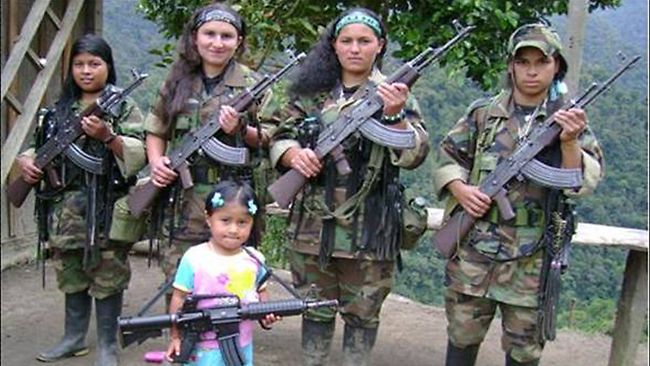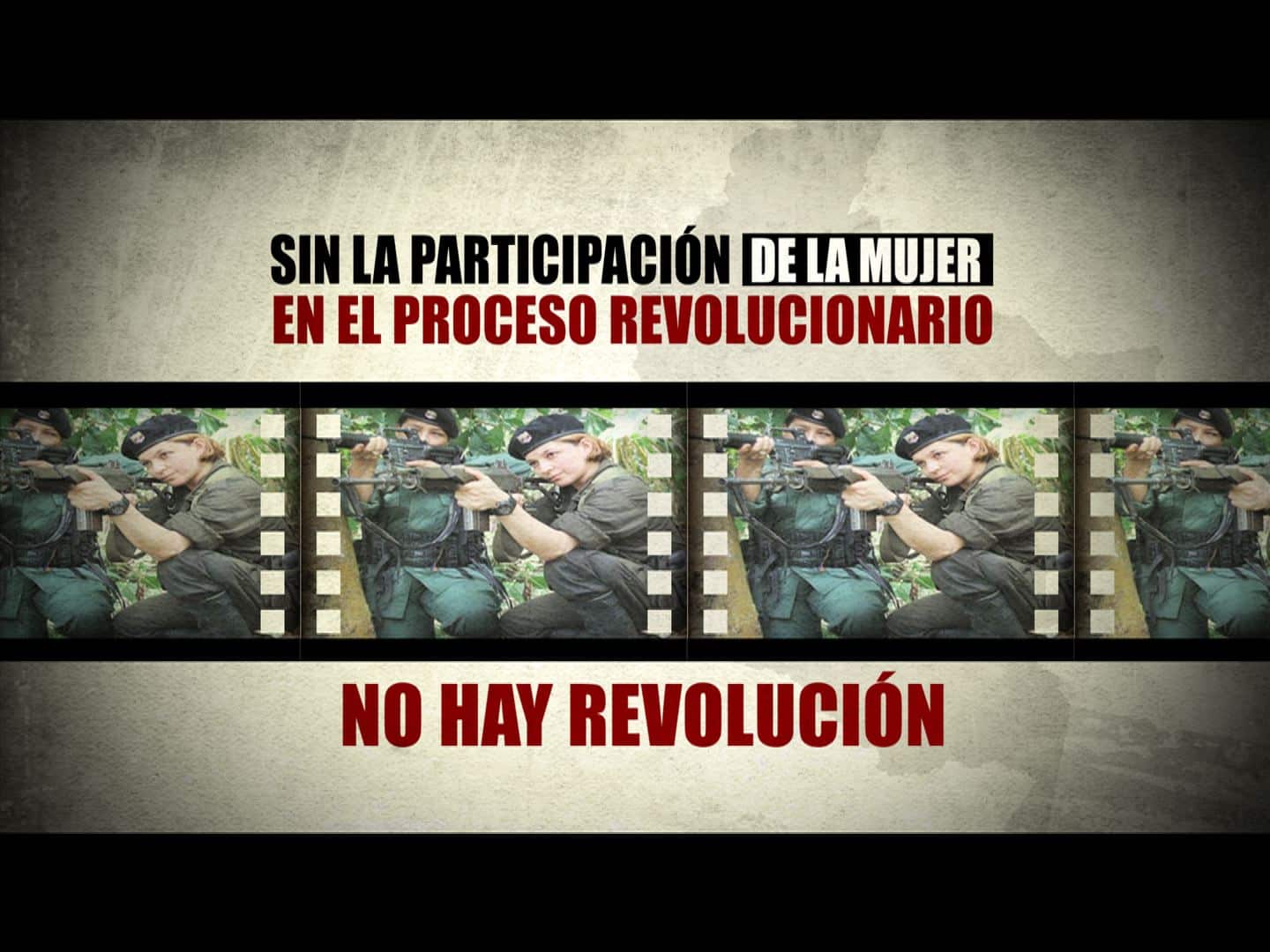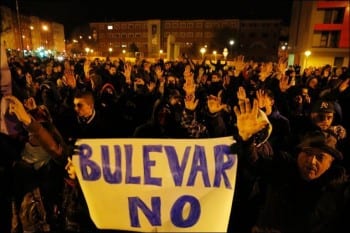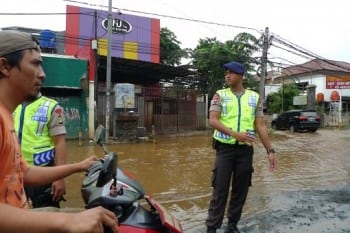More evidence that capitalism never solves its crises
By Jerome Roos, ROAR Magazine

“Not a crisis, but a scam,” reads this eloquent placard.
As David Harvey has noted, and as the ongoing emerging market panic confirms, capitalism never solves its crises — it merely moves them around geographically.
You may not have read about it in the regular media yet, but the financial press is full of it: financial markets are currently experiencing a “bloodbath” over the deepening turmoil in the global periphery.
As I wrote on Friday, five years since the collapse of Lehman Brothers, we may now find ourselves at the start of a new phase in the global financial crisis. Just when European leaders were boasting about their debt problem finally being “under control”, investors are losing their cool over a Chinese slowdown and the Federal Reserve ‘tapering’ its stimulus program. The fear is that the resultant liquidity crunch and commodity slump will negatively affect the ability of some developing countries to pay back the debts they accrued over the past decade of cheap credit.
This fear is now leading to a generalized investor panic roiling financial markets, triggering a collapse in the value of emerging market currencies from Argentina to Turkey to Indonesia to South Africa. Here I don’t want to dwell too much on the specifics of this renewed market panic (you can read more about that inFriday’s report). Rather, I want to take a step back and ask a bigger question that no one really seems to be addressing at this point: how is it that we keep being told by world leaders that “this crisis is over”, and that, every time we are fed that same nonsensical story, some other crisis comes along in another part of the globe, making a mockery out of the official narrative and a fool out of its propagandists in the mainstream media and academia?
A Real Theory of Capitalist Crisis
One of the main reasons for this strange divergence in narrative and reality is that investors, politicians and economists appear to be willfully blind to the internal contradictions that define the capitalist system. The leading geographer David Harvey, in his influential work spanning over four decades and culminating into The Enigma of Capital and the Crises of Capitalism (2010), takes up Marx’s acute insights into these contradictions in order to develop a powerful theory of capitalist crisis. “Capitalism,” Harvey observes, “never solves its crises; it moves them around geographically.” What we are witnessing in emerging markets today is not an overall recovery in the world economy, but a displacement of the crisis from one region to another.
Inspired in particular by the Grundrisse, in which Marx noted that capital cannot abide any limits to continuous circulation, Harvey observes how — every time the process of capital accumulation does encounter such a limit — it must immediately be transformed into a barrier, which can subsequently be bypassed or transcended. Since capital constantly generates surplus value (through the exploitation of wage labor and the rents extracted from interest-bearing credit), it permanently needs to find ways to reinvest this surplus in profitable markets (like the stock market, the housing market, commodity markets and the bond market). This leads to a frantic search on the part of investors for the highest possible yields. In a globalized marketplace, where capital can flow freely from one country to the next, this constant quest for surplus absorption becomes a truly planetary phenomenon, with traders and investors ceaselessly scouring the globe for the best investment opportunities.
How Bubbles Burst
The problem is that accumulation can reach a point where the constant reinvestment of capital ceases to produce adequate returns. When everyone piles in on the same market, it becomes flooded with capital and profit rates eventually diminish. In neoclassical terms, this is called the bursting of a “bubble”, and these bubbles — like their markets — come in multiple forms: housing bubbles, equity bubbles, commodity bubbles and even sovereign debt bubbles (think of Greece). At this point, capitalists will gradually start to divest from these markets in search of more profitable investment opportunities elsewhere. This can set in motion a negative spiral where collective divestment eventually leads to panic: as investors pull their money out of the market, others begin to fear the further devaluation of their assets, and rush for the exits all together — thereby propelling an investor stampede.
While the market in question collapses (whether it’s the market for Greek bonds or US mortgage derivatives), capital must quickly find a way to restore itself to a new equilibrium. Since credit is the lifeblood of any advanced capitalist economy, it is absolutely imperative that the investor stampede does not lead to a systemic freezing up of credit. Debts must be paid, banks must keep lending, firms must keep investing, consumers must keep buying and workers must keep producing. This requires the state and official creditors to step in at crucial moments of investor panic (as in the wake of Lehman’s collapse and Greece’s near-default) in order to ensure the continued circulation and accumulation of capital by pumping emergency credit into the economy — this is the role of the lender-of-last-resort traditionally ascribed to central banks and partially taken up by the International Monetary Fund.
The “Spatial Fix”
The key insight Harvey adds to the theory of capitalist crisis is the notion of the “spatial fix”. Capital has the power (and the need) to constantly bypass limits to continued accumulation not only through emergency loans, an intensification of exploitation, or so-called “accumulation by dispossession,” but it can also temporarily try to displace systemic pressures onto other geographical areas. This is effectively what we’re seeing with the emerging market panic today. At the moment, countries like Turkey, South Africa, Brazil and Indonesia are feeling the brunt of Western investors and central bankers displacing the crisis of Western capitalism onto the global periphery; just like German and French banksdisplaced the European banking crisis onto the eurozone periphery by forcing Greece and other countries to pay the full price — through austerity, reform and full debt repayment — for the banks’ own overexposure; a direct result of their quest for surplus absorption in the lead-up to the crisis.
The emerging market panic is a result of the same quest for surplus absorption and hence an outcome of the same process of spatial displacement. When the US financial system nearly collapsed in 2008, the state stepped in to save and prop up the banking system, and in the resulting recession the Federal Reserve began the process of ‘quantitative easing’, buying up ‘bad debt’ from Wall Street banks in exchange for fresh liquidity (the European Central Bank later did the same through its Outright Monetary Transactions program in 2012). The goal behind this stimulus program was to get the banks to start lending again, thus providing an incentive for investors to invest and for consumers to consume — ideally creating jobs and gradually bringing about recovery. But, given the dismal state of America’s industrial base and the fact that the housing market had already been fully tapped as a means of surplus absorption, Wall Street turned its eyes elsewhere: to emerging markets.
An Emerging Market Bonanza
As the Fed pumped cheap money into the economy in the hope that Wall Street would reinvest this into production, the bankers just took the money and ran with it — to São Paulo, to Istanbul, to Johannesburg. This in turn led to an utterly irrational geographical pattern: while Greece collapsed, neighboring Turkey boomed as it became a major sponge for the absorption of Wall Street’s capital surpluses. US investors lent to Turkish banks which in turn reinvested that money in enormous urban renovation projects, giving rise to a regime ofneoliberal urban development that saw high rises springing up across the Istanbul skyline. In the emerging market bonanza, Turkish Prime Minister Erdogan clearly got high on cheap credit and began to hubristically exceed his popular mandate with megalomaniac construction projects, culminating in the third bridge over the Bosporus and a shopping mall on top of Gezi Park, Istanbul’s last remaining green space — thus giving rise to a major “right to the city” movement, and of course the Gezi uprising of June 2013.
Brazil became another sponge for surplus absorption, sucking up billions of dollars in foreign investments over the course of recent years and reinvesting them into the construction of socially useless World Cup and Olympic stadiums, just as Greece had done in the lead-up to the 2004 Olympics, even as the government failed to provide proper public services to its own citizens. This is the context in which the Brazilian bus fare revolt of June 2013 occurred, coinciding with the protests in Turkey. Other countries that sucked up the capital surplus included Indonesia, Thailand, South Africa and Ukraine, each of which has also experienced major social unrest in recent months as the tide of cheap credit gradually starts to recede, exposing the anemic character of social provisions and the corrupt tendencies of state officials as they got high on cheap credit reinvested by some of the world’s biggest banks.
Another Bubble Bursts
As was to be expected, the flooding of emerging markets produced a familiar pattern: the sponge sucked itself so full of capital that it could absorb no more. Over the course of 2013, yields began to decline and investors grew more and more hesitant to keep reinvesting their capital in emerging market bonds and equities. As the Chinese government simultaneously moved to deflate an epic housing bubble of its own, in the hope of alleviating the pressures on its $4.8 trillion shadow banking system (i.e., off-balance debt), China’s hyper-charged economy finally began to slow down, thus dampening demand for commodities. Since peripheral countries like Argentina, South Africa, Indonesia and Brazil are still largely dependent for their foreign exchange on the export of agricultural and mineral commodities, the resultant commodity slump will seriously affect these countries’ ability to obtain the foreign exchange with which to keep replenishing their central bank reserves and refinance their external debt.
This already precarious situation was further compounded last year when the US Federal Reserve announced that it would be ‘tapering’ (i.e., scaling back) its quantitative easing program, leading investors to fear a contraction in liquidity. This in turn made them even more hesitant to invest in emerging markets, as cheap money from the Fed was a crucial precondition for their willingness to expose themselves to risk in the global periphery. Political instability in Thailand, Ukraine and Turkey further added to the sense of gloom, and when last week Argentina’s central bank was suddenly forced to capitulate in the face of mounting market pressures and let the peso float, its currency lost nearly 15% of its value in a single day, the most dramatic devaluation since the country’s historic economic collapse in 2001-’02. Ever since, emerging markets have been trading in what Benoit Anne, head of emerging market strategy at Société Générale, ominously calls “full-blown panic mode”.
Capitalism is the Crisis
So when you read — as you soon will in the weeks or months ahead — that the emerging market crisis is due to “bad fundamentals” or “bad policies” in countries like Argentina, Turkey, South Africa or Brazil, just remember this: beyond these individual surface manifestations, the deep cause for the coming collapse lies within the internal contradictions of the system itself. Capitalism never solves its crises, it merely moves them around geographically. There will always be bad apples, soft spots and weak links in the chain; there will always be “bad fundamentals” and “bad policies”; there will always be one or another reason to distrust a government’s willingness to pay its debts or honor its financial contracts. But whenever investors are looking for a market that can absorb their surpluses, and that market is going through a period of expansion, no one will complain. As long as there is money to be made, investors don’t care one bit about corruption, laziness or profligacy — because they know full well that these things don’t matter. What matters is yields, returns, profits, rents; as much as possible, as fast as possible and as long as possible. No matter the cost for ordinary people or the environment.
But as soon as the market becomes saturated, yields decline, investors panic and yank their money out; as soon as the tide retreats and prospects for further profits dim, investors are quick to point the finger of blame at whatever moral fault they can find in the national character: the Greeks are lazy, the Turks corrupt, the Brazilians inefficient and the Russians drunk — or any other order of condescension you can imagine. The point is, it doesn’t matter what excuses they come up with. Money talks, and talk is cheap when you’re on the “right” side of the transaction. For Western leaders it’s easy to say that “the crisis is over” today, because for them it is. They simply displaced the costs onto poor American and Spanish homeowners who never got a penny’s worth to save their homes; onto Greek workers, pensioners and youth, who are sitting at home without pay or future; and now onto the Third World’s poor, who will soon suffer the brunt of the adjustment costs their leaders will pass on to them.
The conclusion to all of this is as simple as it is elusive: the only way to overcome the crisis is to overcome capitalism. That option, unfortunately, is not on the voting ballot.
Jerome Roos studied International Political Economy at the London School of Economics and is currently a PhD candidate at the European University Institute, where his research focuses on the structural power of finance capital in sovereign debt crises. He is the founding editor of ROAR Magazine.
::::::::::::::::::::::::
ROAR is maintained by a small group of volunteers without any resources. In the coming year, we want to transform our publication from an activist blog into a proper online journal of the radical imagination. To remain fiercely independent from governments and corporations, we need your help. Check out our crowdfunding campaign and — if you have the opportunity — please consider making a donation.




